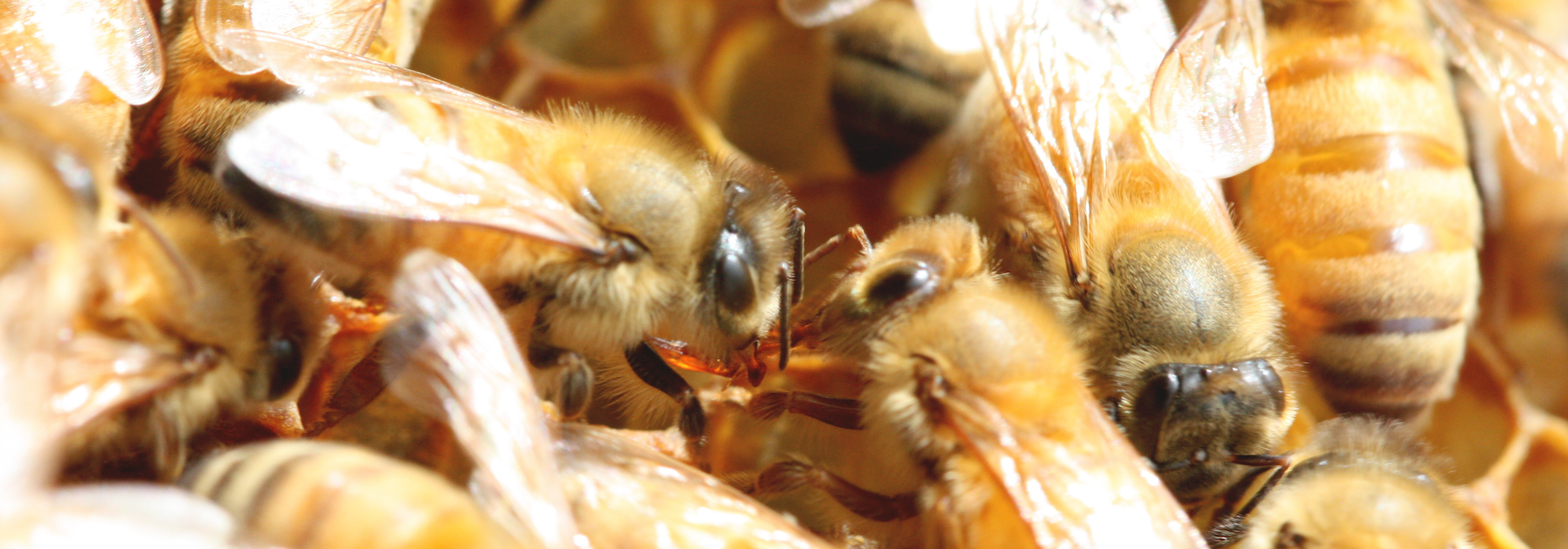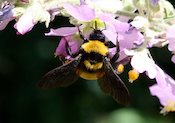Nancy A. Moran
Research
CURRENT RESEARCH
PAST RESEARCH
- Elucidating the molecular bases of species interactions in host-associated bacterial communities
- Role of Gut Microbiota in Honey Bee Health
- Coevolutionary dynamics in an obligate insect symbiosis
- Colonization by a Co-evolved Gut Community
- Dual Obligate Intracellular Symbionts
- Control of Bee Behavior by Stably Engineered Gut Microbial Communities
- Dimensions of Biodiversity: the Gut Microbiota of Bees
- Environmental Genomics of Symbionts in Pea Aphids
- Genomics of Bacterial Symbionts of Plant Sap-Feeding Insects
- Biocomplexity in the Environment
- Bacterial Endosymbiont Diversity in Drosophilla
- Biocomplexity of Symbiotic Bacteria
- Genomic Evolution of Buchnera
- Evolutionary Dynamics of Endosymbiont-Borne Adaption on Aphids
- Molecular Phylogenetics of Sternorrhyncha
- Phylogenetics of Aphids
- Genetically Variable Complex Life Cycles in Heterogeneous Environments
PAST Research Projects

Dimensions: Genomics, functional roles, and diversity of the symbiotic gut microbiotae of honey bees and bumble bees
(PI is Nancy Moran; co-PI is Jay Evans (Bee Laboratory, USDA), collaborator is Rachael Winfree (Rutgers Univ.)
 Microbial gut symbionts are essential for the life of most animal species, but their diversity and functions in hosts and their responses to ecological disturbance are poorly understood. Apis mellifera, the honeybee, possesses a distinctive set of about eight symbiotic bacterial species; some of these also occur in other Apis species and in the related genus Bombus (bumblebees). This study integrates the genomic, taxonomic and functional dimensions of the biodiversity of gut symbionts in these bees. The research will determine genome sequences and metabolic capabilities for these bacterial species and probe how their abundances and gene expression respond when hosts are subjected to different environments. The consequences of altered microbiota for host fitness will be experimentally assessed under nutrient stress and pathogen challenge. The study will also characterize the taxonomic composition of the microbiota of Bombus and Apis species collected globally, with emphasis on North America and China.
Microbial gut symbionts are essential for the life of most animal species, but their diversity and functions in hosts and their responses to ecological disturbance are poorly understood. Apis mellifera, the honeybee, possesses a distinctive set of about eight symbiotic bacterial species; some of these also occur in other Apis species and in the related genus Bombus (bumblebees). This study integrates the genomic, taxonomic and functional dimensions of the biodiversity of gut symbionts in these bees. The research will determine genome sequences and metabolic capabilities for these bacterial species and probe how their abundances and gene expression respond when hosts are subjected to different environments. The consequences of altered microbiota for host fitness will be experimentally assessed under nutrient stress and pathogen challenge. The study will also characterize the taxonomic composition of the microbiota of Bombus and Apis species collected globally, with emphasis on North America and China.
These pollinator species have immense economic, ecological, and agricultural importance; this project will provide new insights into their ecological resilience as mediated by their gut microbes. The data will inform bee conservation and land management policies. This effort will also establish a collaborative exchange with Chinese scientists. Several US students, at different levels, will be trained. High school student researchers and educational activities will be sponsored through the Peabody Museum in New Haven, CT. A large global collection of cryopreserved bees will be established to serve as a reference resource for future changes in bee populations. Overall, this research will provide novel insights into the biology of these important pollinators and their symbiotic microbial biodiversity.
Selected publications
- Kwong WK, Medina LA, Koch H, Sing K-W, Soh EJY, Ascher JS, Jaffé R, Moran NA. 2107. Dynamic microbiome evolution in social bees. Sci Adv. 3(3): e1600513. doi: 10.1126/sciadv.1600513
- Zheng H, Nishida A, Kwong WK, Koch H, Engel P, Steele MI, Moran NA. 2016. Metabolism of toxic sugars by strains of the bee gut symbiont Gilliamella apicola. mBio vol. 7 no. 6 e01326-16. doi: 10.1128/mBio.01326-16
- Elijah Powell J, Ratnayeke N, Moran NA. 2016. Strain diversity and host specificity in a specialized gut symbiont of honey bees and bumble bees. Mol Ecol. 25: 4461-71. doi: 10.1111/mec.13787
- Schwarz RS, Moran NA, Evans JD. 2016. Early gut colonizers shape parasite susceptibility and microbiota composition in honey bee workers. Proc Natl Acad Sci U S A. 113: 9345-50. doi: 10.1073/pnas.1606631113
- Tian B, Moran NA. 2016. Genome Sequence of Hafnia alvei bta3_1, a Bacterium with Antimicrobial Properties Isolated from Honey Bee Gut. Genome Announc. 4(3). pii: e00439-16. doi: 10.1128/genomeA.00439-16.
- Kwong WK, Moran NA. 2016. Gut microbial communities of social bees.Nat Rev Microbiol. 14: 374-384. doi: 10.1038/nrmicro.2016.43
- Kwong WK, Moran NA. 2016. Apibacter adventoris gen. nov., sp. nov., a member of the phylum Bacteroidetes isolated from honey bees. Int J Syst Evol Microbiol. 66: 1323-1329. doi: 10.1099/ijsem.0.000882
- Li J, Powell JE, Guo J, Evans JD, Wu J, Williams P, Lin Q, Moran NA, Zhang Z. 2015. Two gut community enterotypes recur in diverse bumblebee species. Curr Biol. 25: R652-3. doi: 10.1016/j.cub.2015.06.031.
- Kwong WK, Moran NA. 2015. Evolution of host specialization in gut microbes: the bee gut as a model. Gut Microbes. 6: 214-220. doi: 10.1080/19490976.2015.1047129
- Engel P, Bartlett KD, Moran NA. 2015. The bacterium Frischella perrara causes scab formation in the gut of its honeybee host. MBio 6(3). pii: e00193-15. doi: 10.1128/mBio.00193-15.
- Kwong WK, Mancenido AL, Moran NA. 2014. Genome Sequences of Lactobacillus sp. Strains wkB8 and wkB10, Members of the Firm-5 Clade, from Honey Bee Guts. Genome Announc. 2(6) pii: e01176-14. doi: 10.1128/genomeA.01176-14.
- Powell JE, Martinson VG, Urban-Mead K, Moran NA. 2014. Routes of acquisition of the gut microbiota of Apis mellifera. Appl Environ Microbiol. 80: 7378-7387. doi: 10.1128/AEM.01861-14.
- Engel P, Stepanauskas R, Moran NA. 2014. Hidden diversity in honey bee gut symbionts detected by single-cell genomics. PLoS Genet. 10(9):e1004596. doi: 10.1371/journal.pgen.1004596.
- Kwong WK, Engel P, Koch H, Moran NA. 2014. Genomics and host specialization of honey bee and bumble bee gut symbionts. Proc Natl Acad Sci U S A. 111: 11509-11514. doi: 10.1073/pnas.1405838111.
- Cariveau DP, Elijah Powell J, Koch H, Winfree R, Moran NA. 2014. Variation in gut microbial communities and its association with pathogen infection in wild bumble bees (Bombus). ISME J. 8(12):2369-2379. doi: 10.1038/ismej.2014.68
- Martinson VG, Magoc T, Koch H, Salzberg SL, Moran NA. 2014. Genomic features of a bumble bee symbiont reflect its host environment. Appl Environ Microbiol. 80: 3793-3803. doi: 10.1128/AEM.00322-14
- Engel P, James R, Koga R, Kwong WK, McFrederick Q, Moran NA. 2013. Standard methods for research on Apis mellifera gut symbionts. In V Dietemann; J D Ellis; P Neumann (Eds) The COLOSS BEEBOOK, Volume I: standard methods for Apis mellifera research. Journal of Apicultural Research 52(4): http://dx.doi.org/10.3896/IBRA.1.52.4.07
- Engel P, Kwong WK, Moran NA. 2013. Frischella perrara gen. nov., sp. nov., a gammaproteobacterium isolated from the gut of the honey bee, Apis mellifera. Int J Syst Evol Microbiol. 63: 3646-3651.
- Engel P, Moran NA. 2013. Functional and evolutionary insights into the simple yet specific gut microbiota of the honey bee from metagenomic analysis. Gut Microbes 4: 1-6. doi: 10.4161/gmic.22517
- Kwong WK, Moran NA. 2012. Cultivation and characterization of the gut symbionts of honey bees and bumble bees: description of Snodgrassella alvi gen. nov., sp. nov., a member of the family Neisseriaceae of the Betaproteobacteria, and Gilliamella apicola gen. nov., sp. nov., a member of Orbaceae fam. nov., Orbales ord. nov., a sister taxon to the order 'Enterobacteriales' of the Gammaproteobacteria. Int J Syst Evol Microbiol. 63: 2008-2018.
- Tian B, Fadhil NH, Powell JE, Kwong WK, Moran NA. 2012. Long-term exposure to antibiotics has caused accumulation of resistance determinants in the gut microbiota of honeybees. mBio 3(6):e00377-12. doi:10.1128/mBio.00377-12
- Engel P, Martinson VG, Moran NA. 2012. Functional diversity within the simple gut microbiota of the honey bee. Proceedings of the National Academy of Sciences USA. 109: 11002-11007.
- Moran NA, Hansen AK, Powell JE, Sabree ZL. 2012. Distinctive Gut Microbiota of Honey Bees Assessed Using Deep Sampling from Individual Worker Bees. PLoS ONE 7(4): e36393. doi:10.1371/journal.pone.0036393
- Martinson VG, Moy J, Moran NA. 2012. Establishment of characteristic gut bacteria during development of the honey bee worker. 2012. Appl. Environ. Microbiol. 78: 2830-2840.
- Martinson VG, Danforth BN, Minckley RL, O. Rueppell O, Tingek S, Moran NA. 2011. A simple and distinctive microbiota associated with honey bees and bumble bees. Molecular Ecology 20: 619–628.